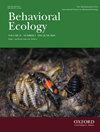Behavioral estimates of mating success corroborate genetic evidence for pre-copulatory selection
IF 2.2
3区 环境科学与生态学
Q2 BEHAVIORAL SCIENCES
引用次数: 0
Abstract
In promiscuous species, fitness estimates obtained from genetic parentage may often reflect both pre- and post-copulatory components of sexual selection. Directly observing copulations can help isolate the role of pre-copulatory selection, but such behavioral data are difficult to obtain in the wild and may also overlook post-copulatory factors that alter the relationship between mating success and reproductive success. To overcome these limitations, we combined genetic parentage analysis with behavioral estimates of size-specific mating in a wild population of brown anole lizards (Anolis sagrei). Males of this species are twice as large as females and multiple mating among females is common, suggesting the scope for both pre- and post-copulatory processes to shape sexual selection on male body size. Our genetic estimates of reproductive success revealed strong positive directional selection for male size, which was also strongly associated with the number of mates inferred from parentage. In contrast, a male’s size was not associated with the fecundity of his mates or his competitive fertilization success. By simultaneously tracking copulations in the wild via the transfer of colored powder to females by males from different size quartiles, we independently confirmed that large males were more likely to mate than small males. We conclude that body size is primarily under pre-copulatory sexual selection in brown anoles, and that post-copulatory processes do not substantially alter the strength of this selection. Our study also illustrates the utility of combining both behavioral and genetic methods to estimate mating success to disentangle pre- and post-copulatory processes in promiscuous species.对交配成功率的行为评估证实了繁殖前选择的遗传证据
在杂交物种中,从遗传亲本中获得的适合度估计值通常可能反映了性选择的交配前和交配后因素。直接观察交配有助于分离出交配前选择的作用,但这种行为数据很难在野外获得,而且还可能忽略改变交配成功率与繁殖成功率之间关系的交配后因素。为了克服这些局限性,我们将遗传亲子关系分析与褐踝蜥(Anolis sagrei)野生种群中体型特异性交配的行为估计相结合。该物种的雄性体型是雌性的两倍,而且雌性之间的多次交配很常见,这表明在雄性体型的性选择过程中存在着交配前和交配后的过程。我们对繁殖成功率的遗传估计显示,雄性体型具有很强的正向选择性,这也与根据亲代推断的配偶数量密切相关。相比之下,雄性个体的大小与其配偶的繁殖力或竞争性受精的成功率无关。通过同时追踪不同体型的雄性在野外向雌性传递彩色粉末的交配情况,我们独立证实了大体型雄性比小体型雄性更有可能交配。我们的结论是,体型在褐鳌虾中主要处于交配前的性选择之下,交配后的过程并不会显著改变这种选择的强度。我们的研究还说明了结合行为学和遗传学方法来估计交配成功率的实用性,以区分杂交物种的交配前和交配后过程。
本文章由计算机程序翻译,如有差异,请以英文原文为准。
求助全文
约1分钟内获得全文
求助全文
来源期刊

Behavioral Ecology
环境科学-动物学
CiteScore
5.20
自引率
8.30%
发文量
93
审稿时长
3.0 months
期刊介绍:
Studies on the whole range of behaving organisms, including plants, invertebrates, vertebrates, and humans, are included.
Behavioral Ecology construes the field in its broadest sense to include 1) the use of ecological and evolutionary processes to explain the occurrence and adaptive significance of behavior patterns; 2) the use of behavioral processes to predict ecological patterns, and 3) empirical, comparative analyses relating behavior to the environment in which it occurs.
 求助内容:
求助内容: 应助结果提醒方式:
应助结果提醒方式:


